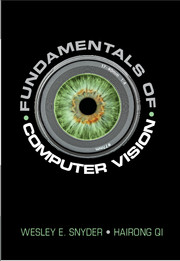Book contents
- Frontmatter
- Dedication
- Contents
- Preface
- For the Instructor
- Part I Preliminaries
- Part II Preprocessing
- Part III Image Understanding
- 8 Segmentation
- 9 Parametric Transforms
- 10 Representing and Matching Shape
- 11 Representing and Matching Scenes
- Part IV The 2D Image in a 3D World
- A Support Vector Machines
- B How to Differentiate a Function Containing a Kernel Operator
- C The Image File System (IFS) Software
- Author Index
- Subject Index
- References
8 - Segmentation
from Part III - Image Understanding
Published online by Cambridge University Press: 25 October 2017
- Frontmatter
- Dedication
- Contents
- Preface
- For the Instructor
- Part I Preliminaries
- Part II Preprocessing
- Part III Image Understanding
- 8 Segmentation
- 9 Parametric Transforms
- 10 Representing and Matching Shape
- 11 Representing and Matching Scenes
- Part IV The 2D Image in a 3D World
- A Support Vector Machines
- B How to Differentiate a Function Containing a Kernel Operator
- C The Image File System (IFS) Software
- Author Index
- Subject Index
- References
Summary
The partition between the sage and the fool is more slender than the spider web.
– Kahlil GibranIntroduction
Segmentation is the process of separating objects from background. It is the foundation for all the subsequent processes like shape analysis and object recognition.
A segmentation of a picture is a partitioning into connected regions, where each region is homogeneous in some sense and is identified by a unique label. For example, in Figure 8.2 (a “label image”), region 1 is identified as the background. Although region 4 is also background, it is labeled as a separate region, since it is not connected to region 1.
The term “homogeneous” deserves some discussion. It could mean all the pixels are of the same brightness, but that criterion is too strong for most practical applications. It could mean that all pixels are close to some representative (mean) brightness. Stated more formally [8.56], a region is homogeneous if the brightness values are consistent with having been generated by a particular probability distribution. In the case of range imagery [8.31] where we (might) have an equation that describes the surface, we could say a region is homogeneous if it can be described by the combination of that equation and some probabilistic deformation. For example, if all the points in a region of a range image lie in the same plane except for deviations whose distance from the plane may be described by a particular Gaussian distribution, one could say this region is homogeneous.
In this chapter, several ways to perform segmentation are discussed.We progress through problems and methods of increasing complexity:
• (Section 8.2) Threshold-based techniques are guaranteed to form closed regions because they simply assign all pixels above (or below, depending on the problem) a specified threshold to be in the same region. However, using a single threshold only allows regions to be classified as “foreground” and “background.”
• (Section 8.3) Brightness segmentation into two classes is the simplest case. It becomes more challenging when color images are considered and similarities of colors must be considered.
• (Section 8.4) Another level of complexity occurs when it is necessary to determine whether two apparently separate regions are really one region. That is, do they touch? For this, we need connected components.
- Type
- Chapter
- Information
- Fundamentals of Computer Vision , pp. 149 - 199Publisher: Cambridge University PressPrint publication year: 2017
References
- 1
- Cited by



